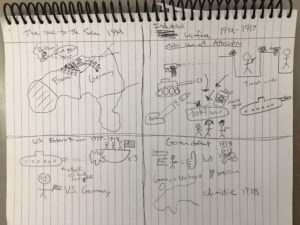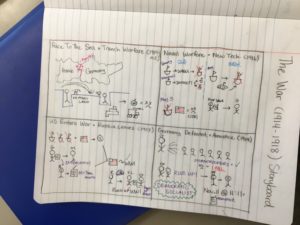One huge benefit of the Four Question Method is the clarity it provides to teachers and students about what intellectual task is on the table at any given time. When teachers plan and teach with the 4QM, everyone in the classroom knows whether they are narrating, interpreting, explaining, or judging. Recently I’ve been experimenting with designing my summative essay questions explicitly around the Four Questions as well. Writing my essay questions this way means breaking them down into sections and identifying clearly which of the Four Questions is being asked in each section. Here’s an example: a sophomore essay question about the Versailles Treaty. I’ve learned to letter the parts of the assignment, not number them, in order to avoid confusion with the question numbers. Part A is a Question One, part B is a Question Two, and part C is a Question Four:
THE VERSAILLES TREATY
ESSAY ASSIGNMENT
As you know, the Versailles Treaty which ended The Great War (WWI) was very controversial. For this essay you will be asked to describe some key elements of the treaty, consider what the leaders of the major signatories to the treaty were thinking when they signed it, and then to make your own judgment about the treaty.
Write an essay in which you do the following:
A. Describe the main provisions of the Versailles Treaty related to Germany: the “war guilt clause,” the loss of territory, reparations payments, and limits on the German military. [Q1]
B. Say what the leaders of Britain, France, and Germany thought about these provisions at the time the treaty was signed. [Q2]
C. Say if you think these provisions of the treaty were fair or not, and explain the reasoning behind your judgment with specific reference to events we have studied in this unit. [Q4]
Benefits Of This Question Format
Breaking the essay question down this way has a number of benefits. First of all, it helps me to avoid writing ambiguous questions (here’s a recent blog post about that challenge). Since I know I’ll have multiple sections of the prompt, I don’t get caught up in writing one big question that tries to do too much. And since I know each part of the prompt has to be only one of the Four Questions, I’m much more clear in my own thinking about what I want students to do.
This format is also a huge help to students who struggle with organization. I sometimes coach these students to think of the assignment as three separate essays — with one student this year I actually had him make three separate files on his computer, one for each part of the question — so that they can concentrate on one thing at a time. When they’ve answered parts A, B, and C separately we stack them together and write an introduction and conclusion for the whole stack — voila! A finished essay!
This format also makes it easier for me to provide feedback and coaching to students who need it. When the prompt is written in this fashion it’s easy to see who has problems of organization (they’re putting their judgment of the treaty in part A, for example), who has problems of substance (they’re not providing specifics to support their judgment in part C, for example), and who has both. Students’ clarity or confusion is often evident in their topic sentences, since each topic sentence should answer one part of the prompt. Consider these strong examples, one from part A and one from part C of two different student papers:
“The main provisions of the Versailles treaty took back German territory, weakened German military forces, created a demilitarized zone, and demanded that Germany pay all reparations for the cost of the war.”
“The treaty of Versailles was unfair to Germany because they did not cause the war by themselves.”
Is It Too Easy?
Some readers might think that writing essay questions like this does too much for students, and that by giving them such an explicit structure for their essays we’re making their task too easy. I can see that argument, especially for advanced students. But as teachers we need to consider what it is we want our students to focus their intellectual energy on. Do we want them to think about their answers to the history questions we’re asking? Or do we want them to have to figure out which history questions we’re asking, and then think about their answers to those questions? Clear questions mean that students’ energies go into actually doing history, and my energy goes into coaching them on the skills required to do history well. Most of the time that’s where I want our energies spent.
So try pulling your next essay question apart, and revising it 4QM-style, and let us know how it goes. I invite readers to email us some sample questions at info@4qmteaching.net, and we’ll make them the subject of an upcoming blog post.
J.B.

